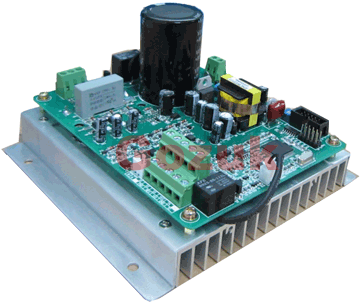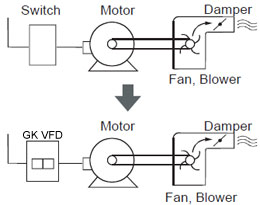Inverter duty motor vs Standard motor on VFD
If 2 pole 50 hz standard motor run with 4:1 ratio what will be temperature rise expected?
And
if 2 pole 50 hz inverter duty motor runs with 4:1 ratio what will be temperature rise expected? Like "inverter duty motor will give 4 time life then standard motor?"
I know that you can use inverter duty motor with 10:1 ratio. while standard motor 2:1. I know VFD (variable frequency drive) operating range for positive displacement Pumps. Positive displacement Pumps never use Inverter duty motor even to getting a ratio 5:1 with 4 pole motor. Instead they prefer to use reduction drive, which decrease the overall efficiency of system and add extra cost.
Temperature rise is the difference between the ambient and the hot winding temperature. A motor with a 1.15 SF and class F insulation (for 1500 Hp and less) is rated at 125C per NEMA MG-1. Class A insulation is rated at 80C and class B is 100C. You can ask for an embedded detector in the motor to monitor the motor temp.
To calculate motor temp rise, hot winding temp needs to be known and there is a formulae that involves hot temperature, cold temperature, hot resistance, cold resistance and a K constant (234.5) for copper.
Motor manufacturers classify their motors as inverter duty when they use a class F insulation. Will it give 4 time more life time than standard class A or B? Not really. They wind their motors per NEMA MG-1 classification.
The number of poles shouldn't have anything to do with it. You can vary a 6-pole motor just as easily as a 2-pole. You just get a different speed range out of the shaft. You can even go over speed. I've run regular induction motors at 75 hz before. With proper engineering attention, you can go a lot higher.
Emphasis is on correct engineering. Stepping up motor speed with variable frequency drive (VFD) creates a problem of overheating of windings, overheating of stampings and magnetic saturation of motor stampings. If all these are taken care of, stepping up by a ratio of 2:1 may even be possible. Economics do not favor this arrangement. I do not understand why anyone would want to use VFD for high ratio seed variation when alternative methods are less expensive and more energy efficient.
And
if 2 pole 50 hz inverter duty motor runs with 4:1 ratio what will be temperature rise expected? Like "inverter duty motor will give 4 time life then standard motor?"
I know that you can use inverter duty motor with 10:1 ratio. while standard motor 2:1. I know VFD (variable frequency drive) operating range for positive displacement Pumps. Positive displacement Pumps never use Inverter duty motor even to getting a ratio 5:1 with 4 pole motor. Instead they prefer to use reduction drive, which decrease the overall efficiency of system and add extra cost.
Temperature rise is the difference between the ambient and the hot winding temperature. A motor with a 1.15 SF and class F insulation (for 1500 Hp and less) is rated at 125C per NEMA MG-1. Class A insulation is rated at 80C and class B is 100C. You can ask for an embedded detector in the motor to monitor the motor temp.
To calculate motor temp rise, hot winding temp needs to be known and there is a formulae that involves hot temperature, cold temperature, hot resistance, cold resistance and a K constant (234.5) for copper.
Motor manufacturers classify their motors as inverter duty when they use a class F insulation. Will it give 4 time more life time than standard class A or B? Not really. They wind their motors per NEMA MG-1 classification.
The number of poles shouldn't have anything to do with it. You can vary a 6-pole motor just as easily as a 2-pole. You just get a different speed range out of the shaft. You can even go over speed. I've run regular induction motors at 75 hz before. With proper engineering attention, you can go a lot higher.
Emphasis is on correct engineering. Stepping up motor speed with variable frequency drive (VFD) creates a problem of overheating of windings, overheating of stampings and magnetic saturation of motor stampings. If all these are taken care of, stepping up by a ratio of 2:1 may even be possible. Economics do not favor this arrangement. I do not understand why anyone would want to use VFD for high ratio seed variation when alternative methods are less expensive and more energy efficient.
Post a Comment:
You may also like:
Featured Articles
Non-Enclosure Variable Frequency Drive ...
 No enclosure (cover), reducing installation space and cost effective. Widely used in All-In-One control cabinet. Keep the same ...
No enclosure (cover), reducing installation space and cost effective. Widely used in All-In-One control cabinet. Keep the same ...
 No enclosure (cover), reducing installation space and cost effective. Widely used in All-In-One control cabinet. Keep the same ...
No enclosure (cover), reducing installation space and cost effective. Widely used in All-In-One control cabinet. Keep the same ...Variable frequency drive application ...
 Variable Frequency Drive (VFD) can be used in lots of fields. Variable frequency drives are widely used to control the speed of ...
Variable Frequency Drive (VFD) can be used in lots of fields. Variable frequency drives are widely used to control the speed of ...
 Variable Frequency Drive (VFD) can be used in lots of fields. Variable frequency drives are widely used to control the speed of ...
Variable Frequency Drive (VFD) can be used in lots of fields. Variable frequency drives are widely used to control the speed of ...Variable frequency drive in HVAC ...
 Variable frequency drives (VFD) have been used for HVAC systems in buildings for more than 40 years. But only in recent years, ...
Variable frequency drives (VFD) have been used for HVAC systems in buildings for more than 40 years. But only in recent years, ...
 Variable frequency drives (VFD) have been used for HVAC systems in buildings for more than 40 years. But only in recent years, ...
Variable frequency drives (VFD) have been used for HVAC systems in buildings for more than 40 years. But only in recent years, ...Variable Frequency Drive Harmonics and ...
A discussion of the benefits of variable frequency drives often leads to a question regarding electrical harmonic distortion ...
Three phase inverters
 In the variable frequency drive rectifier paper, it explains how to go from three phase alternating current voltage to a direct ...
In the variable frequency drive rectifier paper, it explains how to go from three phase alternating current voltage to a direct ...
 In the variable frequency drive rectifier paper, it explains how to go from three phase alternating current voltage to a direct ...
In the variable frequency drive rectifier paper, it explains how to go from three phase alternating current voltage to a direct ...
VFD manufacturers

i have lathe machine .there is 2hp motor for spindle.i think to upgrade it with 5hp standard motor and 7.5 hp drive.please tell me other alternative method for this.